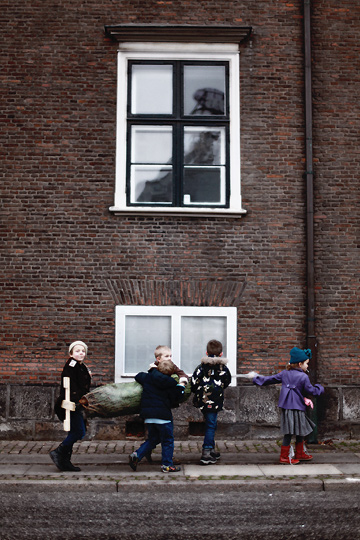
I didn't mean to neglect this little place for so long, but I think I've just done it - again. It's been more than a month - or rather like two! - since my last post around here, and a lot has happened between then and now. If you happen to have seen me on twitter recently, you might know I was on my travels in Europe from late October to the beginning of December. It was an incredible trip packed with some amazing experiences to have, awesome people to meet, and of course fantastic food to savor. I'm afraid I might not be able to go over everything here, but hoping to feature the highlights of the trip in the coming weeks, either here on this blog or on my flickr pages.
But for today, I thought I'd pop up and say a few things about the town I visited at the very end of my six-week trip: Copenhagen. Capital of Denmark and the host of recent COP-15, the picturesque Nordic city was long on my list of 'dream' places to visit; in the past I'd been to the airport for a layover, true, and even though the Copenhagen airport is located very close to the city center - 15 minutes by train to the central station -, my few hours at the airport still wouldn't count as 'visiting' the city for real.
So this time, though it was only for three days, I was really excited to finally set foot on the city (out of the airport!). And Copenhagen didn't disappoint us, despite the weather (dull, rain on and off), the temperatures (cold - highs 1-3C/35-40F; it would be even colder now), and the general prices (ridiculously high - to me anyway). The streets were clean and pretty, especially with all the colorful Christmas decorations that were lit up from as early as 3 o'clock in the afternoon, as the day is remarkably short during the winter months at such high latitudes.

- Tivoli Gardens
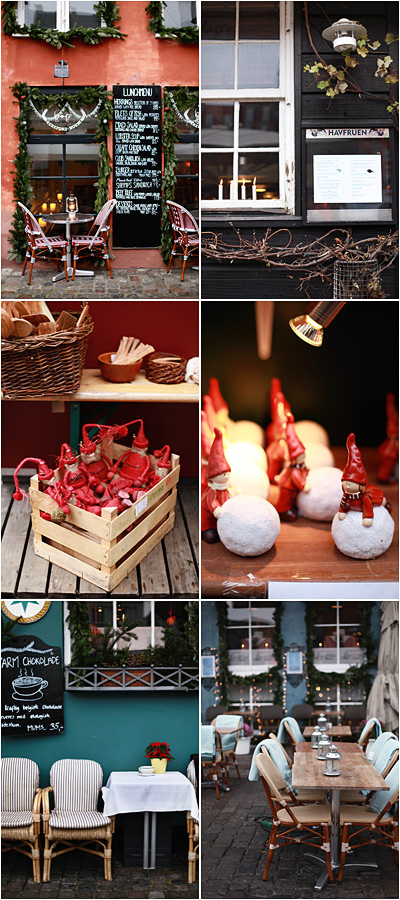
- Nyhavn
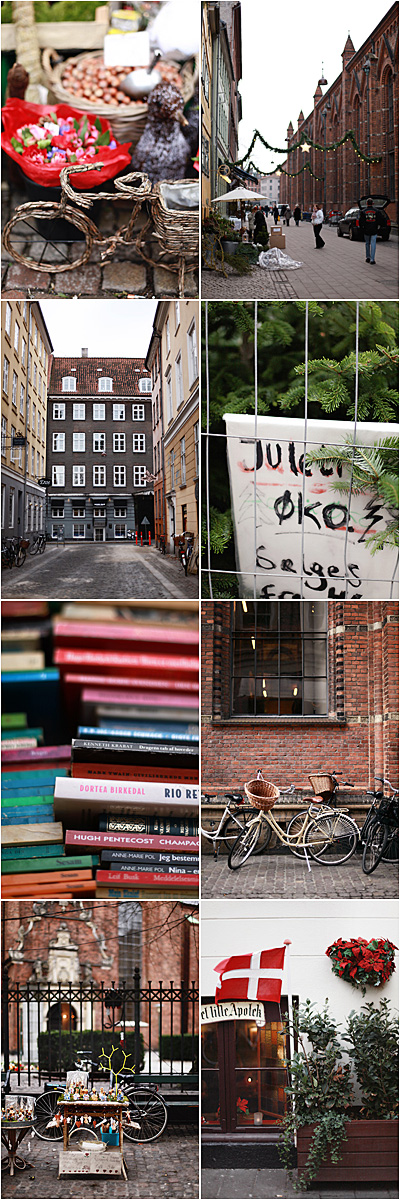
- Indre By
Whether it was Christmas decoration at Tivoli Gardens, cafes and Christmas market in the Nyhavn district, or random small streets in the Indre By district, everything looked pretty no matter where I pointed my camera at.
Granted, we only made it to super-touristic areas this time, but I was fascinated by the town that lived up to its image as being the 'kingdom of fairy tale' so well, and it might have been looking even prettier with all the Christmas decorations. I just wish I had taken more pictures while in town. The damp and cold weather wasn't exactly encouraging - at least that's my excuse.
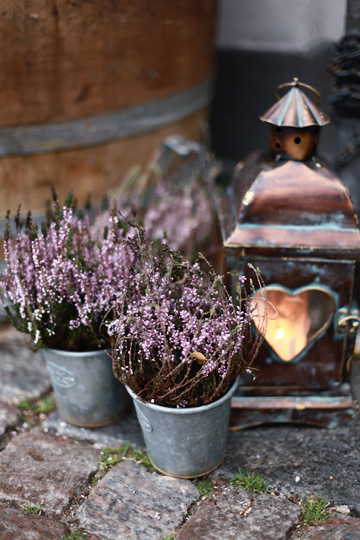
But I did manage to take some pretty pictures and thought I'd share them with you; they are available to view here as slideshow.
As pretty as the city may be, however, one cannot live by appreciating pretty townscape alone; you need to fill your stomach (and warm yourself up, especially in a cold place like this). And Copenhagen fared pretty well on this front, too - provided that you refrain from converting every single price tag for the things you eat or wish to eat. (Well, to be fair, not everything is outrageously expensive. But not cheap, either. Definitely not.)
I would have liked to try the places I've heard of (there were a few), but we didn't get a chance to book a table, and instead ended up playing things mostly by ear - just walked about and tried things we found as we went.
That lead us to eat our food often at some random delis/restaurants as well as from street vendors, and we braved the cold, bundled up in a coat, gloves, scarfs, and nifty hand- and boot-warmers I'd brought all the way from Japan back in October, just to be ready for Copenhagen in December.
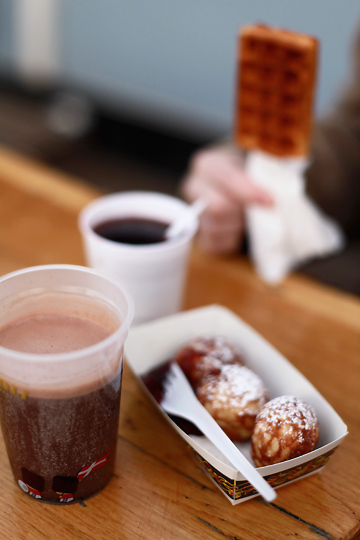
One breakfast we had at the Tivoli Gardens (although it happened at 2pm, but it was our first meal of the day nonetheless) consisted of a warm waffle on the stick, triplets of aebleskiver (æbleskiver; pancake puffs), a huge cup of hot chocolate, and a small(ish) cup of glogg (glögg or gløgg - Scandinavian version of mulled wine) with a shot of rum. Both aebleskiver and glogg are considered Danish Christmas-time specialties, and we'd see them at practically every corner of the town throughout our stay in Copenhagen.
Other street food we tried:
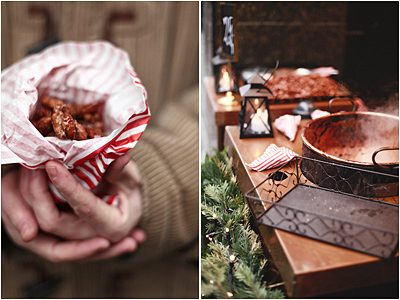
Braendte mandler, which I assume were caramelized almonds; walking along the streets in Copenhagen during the Christmas time, you'd no doubt pick up that sweet, warm smell of caramel cooking and almonds roasting drifting over, and chances are slim that you could hold yourself from being drawn to the first vendor you can find that offers the warm, caramel-coated almonds. Sold in a paper cone, they make excellent nibbles as you stroll down the streets, although I would have liked the portion to be a little larger - but maybe it was a good thing, as no matter how large a portion gets, I'd no doubt polish it off in minutes, if not seconds.
And speaking of street vendors...
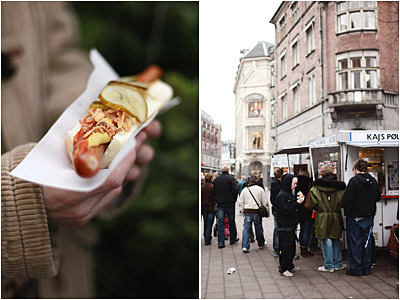
Hot dog from one of the numerous pølsevogn (literally, "sausage wagon"). This, I understand, is a Denmark institution, and you simply can't leave Copenhagen without trying this (or so I believe). It may seem like any other hot dog you know, and it actually is, except you have an infinite number (or so it seems) of choice of sausage, roll, and topping. Okay, maybe not infinite; it's basically a sausage in a roll with a smear of ketchup and mustard, topped with some fried onions and pickles. But you do have a quite a lot of different kinds of sausages to choose from, and you can certainly pick toppings/condiments you like.
I can't point you to a specific pølsevogn that you should try, but we've tried a few different places between us and found that they do vary in taste - so should you ever find yourself in Copenhagen (or any other town in Denmark), I encourage you to try as many different vendors (and hot dogs, of course) as you can possibly shove into your mouth to find the 'best' hot dog in town. A bottle of beer will help you wash it down along the way, for sure.
Speaking of beer, by the way, we tried julebryg, or Christmas beer, which was a slightly sweet dark ale with a hint of spices. I enjoyed it with a plate of sausages and sauerkraut at a beer restaurant.
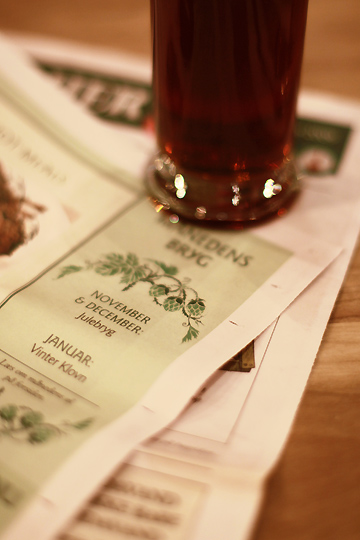
I'd later see a bunch of different Christmas beers at the stores, and even bought one for home. I picked one from Tuborg for its fun label (like this).
Julebryg may be a Danish Christmas specialty, but what I really enjoyed while in Copenhagen was mulled wine - or glogg. I find myself taking every opportunity to grab a cup of mulled wine from street vendors whenever I find one, everywhere I go in Europe during cold months, especially around Christmas; a steaming-hot cup (or three) of sweet, spiced red concoction seems to not only warm your hands and body but lift your spirits up a bit as you make your way along a stone-paved walk under the heavy clouds that hang low. To me, mulled wine seems to make the dark, depressing European winter a tad more manageable.
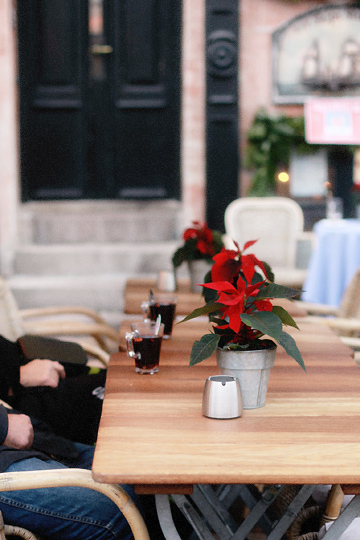
So it seemed only natural for me to be tempted to try and see how Scandinavians do it now that I was actually there. Now before going to Copenhagen, I'd always thought that glogg is, basically, mulled wine with a shot of spirit added to it. In Copenhagen, they did seem to add spirits like akvavit and vodka, but it is optional; you don't have to add any spirit to your spiced wine and you can still call it glogg.
What appeared to be a more typical add-on to glogg than a spirit was raisins and slivered almonds. When I first saw glogg served this way, I was a bit skeptical about the almonds; raisins are okay, but the idea of putting nuts in liquid just didn't appeal to me too much (soggy nuts anyone?). But when I actually tried it, I found myself picking up more almonds than raisins - they were good! I quickly became a convert.
While I enjoyed every occasion to sip glogg, it didn't occur to me to buy some for home, like I did with beers. I did see things like just-add-wine "glogg mix", which usually consisted of a mixture of spices and almonds, or even pre-made, ready-to-serve bottles. But they just didn't click. For one, you don't need to buy such things to serve your own mulled wine, nor do you need to take them halfway around the world; all you need to make your pot of mulled wine you can buy back in Japan. Besides, I rarely make mulled wine at home; to me, it's something I crave when I am out and about when it's cold, and not necessarily at home in a warm room.
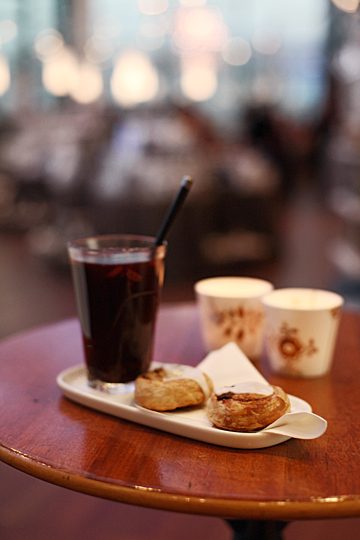
(I didn't bring glogg or a glogg mix home, but had my last glass at the Copenhagen airport - along with two mini-sized, over-priced julebolle. It helped alleviate my sadness to leave Europe, but also made me almost miss my flight - oh I've never run so madly at an airport!)
That said, I did have a craving for mulled cider for some time after coming back from Copenhagen to Tokyo earlier this month. I suspect that it was because of a glass of aebleglogg (æblegløgg) that I never had while in Copenhagen.
At one deli/cafe at the basement of a department store in town where we stopped for something hot to drink (and eat), I ordered a glass of glogg. Or I thought I had; I was then told, "We're sorry, but we are out of the apple glogg. Would you like the one with red wine instead?" For a moment I didn't know what they were talking about, but then got it; the glogg on the menu board I'd seen was actually æblegløgg, or "apple glogg". Being clueless about Danish language and generally ignorant to details that I didn't understand, I overlooked the "æble" part and thought it was just a regular glogg.
So I accepted their suggestion of substitution and had a glass of red wine glogg, which tasted lovely. But even though I simply had something I had intended to have, I felt like I was missing out, and the more I looked at the menu board that showed the picture of aebleglogg and said - which I now could see upon close inspection - they have an option of an added shot of calvados, I grew more and more curious.
Aebleglogg, which can be translated as "apple mulled wine", is a version of mulled wine that is made using apple juice in place of wine. It's basically mulled cider, but with raisins and almonds, and an optional shot of spirit. When I had the craving for mulled cider late at night for two days in a row, I did myself a favor and made a batch. It did a trick and my craving was satisfied for the time being, but I was still feeling that I should be doing more "proper" aebleglogg.
So when I came to Nagano in mid December to help my mother and her family with their apple-selling business, I was secretly determined to make another batch (or two) using their apples. There would be no need to make a mad dash to a nearby convenience store at 2 o'clock in the morning just to buy a mediocre carton of apple juice.
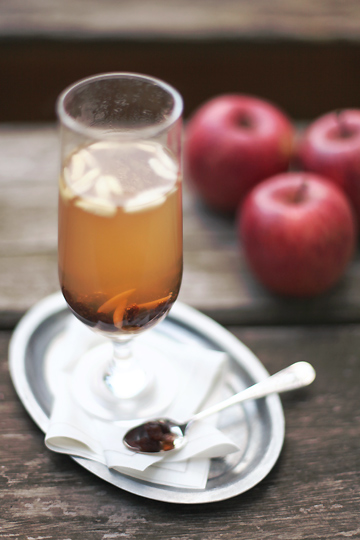
What I did was simply juicing a basketful of apples (Fuji this time) and warmed it in a pot with a few slices of fresh ginger root and a bit of juice of lemon to prevent the juice from turning too brown. I wanted to use other spices, too, but I was out of them at that time. There was absolutely no need to add sugar or any other sweetener; if you have ever prepared your own cider using the sweetest Fuji apples grown in Nagano, you'd know they make extremely sweet juice.
Served warm along with raisins and slivered almonds, it tasted great in a chilly afternoon. Even so (or maybe because of it), I still wanted to make it again, using other spices than ginger and have it with a spirit - calvados, that is.
So try I did, this time late in the evening, in a warm room, chatting away with mother who did the job of peeling a dozen of apples (which is the hardest part in making mulled cider, I think)...
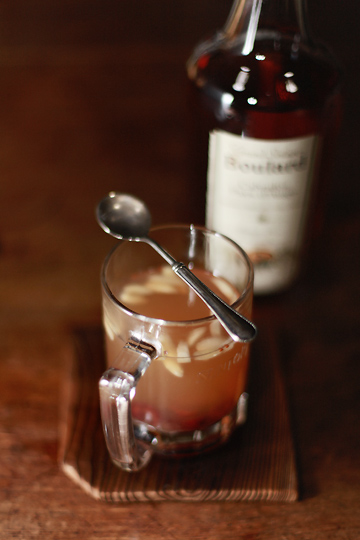
And it was about the best mulled cider I've ever had - not sure if it was because of the tastiest apples we used, addition of almonds, or a generous shot of calvados. Maybe all of the above.
Aebleglogg (Scandinavian-style Mulled Cider) with Calvados
In a large pot over a medium-high heat, warm a quart (approx. 1 liter/ 4 cups) of apple juice along with 4-5 slices of fresh ginger root, a cinnamon stick or two, a few cloves, and a few crashed cardamom pods. Bring it to a gentle simmer, then reduce the heat to low and simmer, without bringing it to a boil, for 10-20 minutes. Remove from heat and, if you prefer, add honey or sugar syrup to taste. To serve, strain through a sieve to remove the spices and pour in a glass, and add some raisins or dried cranberries, and slivered (or sliced) almonds. Add a shot of calvados (optional, but highly recommended). Makes 4-5 glasses.
*If possible, I highly recommend that you press your own fresh apple cider (juice). Feel free to use other spices in addition to the ones listed above, such as allspice and nutmeg. Apples vary widely in sweetness, so adjust the amount of sweetener to your taste (in my case, I didn't add any). Add some juice of lemon if you think your cider is too sweet and/or needs some tartness. If you have time, leave the warmed cider to rest, with all the spices left in, in the fridge for a few hours or overnight for an improved flavor (reheat before serving). If you don't have calvados around, you can certainly use a regular brandy.
If you are interested, you might like to take a look at the recipe for æblegløgg, by the very deli/cafe that I tried (without knowing) to have it: here (in Danish). If Google Translation does good enough a job, I understand that they caramelize the sugar first before adding apple juice to the pot, which sounds a kind of good.
I have always enjoyed mulled cider, but from now on I think I will have mine with almonds and raisins added - as well as calvados. And I'll always think of our time in the cold but festive Copenhagen - even though I didn't actually have a chance to drink it while I was there.
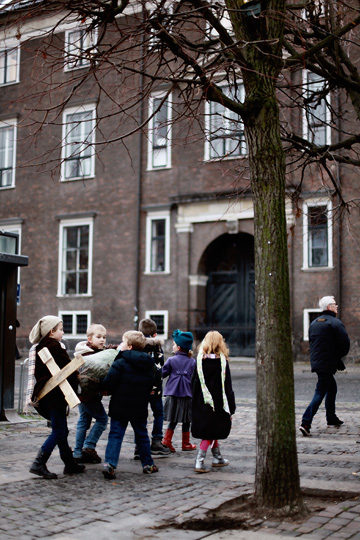
Photo: Copenhagen before Christmas (slideshow)
P.S. Thanks so much to you Drew, for spending time with me and looking after me. Things would have been very, very different had you not been there. So thank you. -c xo

3 comments:
oooooooooh! happy holidays! God bless!
Wow! Jealous! Looks like a wonderful holiday.
xox Sarah
The æbleskiver and the apple glogg look delicious! I always make mulled wine during Christmas using a Finnish glogg syrup plus spices, orange juice and fruits. I may try the mulled cider this year.
Post a Comment